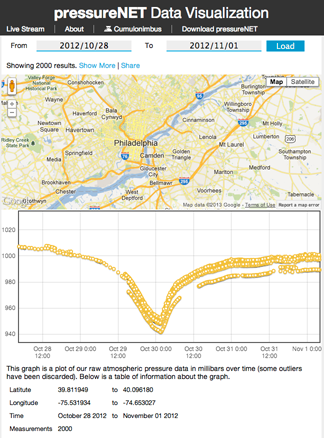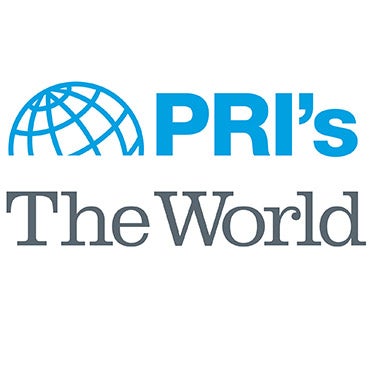Sandy silver lining: Storm helped app developers inch closer to ‘nowcasting’ weather

Two Canadian-based software developers are inching closer to their goal of instant, local weather prediction with a little help from an unpredictable source: Superstorm Sandy.
The story starts two years ago, when Montreal-based software developer Jacob Sheehy was surprised to learn that the new Motorola Xoom tablet computer would come standard with a curious tool: an atmospheric pressure sensor.
“I saw it had a barometer and I thought ‘Oh wow, Google must be building a giant weather network,'” Sheehy said.
So he waited, but Google never did build that network.
“So, I said, ‘Well I’m going to do it,'” Sheey said.
Sheehy and his business partner at Cumulonimbus Software launched the app pressureNET. It is for the Xoom tablet and newer Android phones, which now come standard with a barometer. The software can pull pressure readings from phones every 10 minutes, aggregate them, and post them online.
The goal? Gather hundreds of thousands of readings a day to offer real-time, highly localized weather predictions.
“You could look at your phone and will see an alert from pressureNET saying there is an incoming storm, it will arrive at your location in 20 minutes,” Sheehy said.
 Tracking Sandy, users accumulated
Tracking Sandy, users accumulated
For that kind of forecast – or “nowcast” – you need a lot of data, and downloads of the app were slow for the first year. Then Superstorm Sandy started heading for the U.S. Users in the Northeast posted online, asking others with Android phones to help track the storm. Sheehy said active users doubled to around 2,000 in just a few days.
“I think the combination of people desiring to help and learn about science, and help researchers, along with this sort of unprecedented event, just drummed up a lot of enthusiasm and excitement,” Sheehy said.
Now, new Android phone roll-outs, online mentions and media coverage have helped boost the number of active users to about 6,000 by Tuesday afternoon, according to Sheehy.
Phillyweather.net editor and occasional Newsworks.org contributor Tom Thunstrom said barometers used in forecasting now are typically just at airports and weather stations, often 10, 20, even 30 miles apart.
“If you’ve got 300 users that are within two to three miles contributing data, that’s going to provide a lot more relevant and real time data, especially if it comes to thunderstorm aspect of it,” Thunstrom said. “Thunderstorms can be very small scale. You can have a thunderstorm in the summer pop up over Center City while in South Philly, it’s sunny.”
In the winter, pressure changes can help forecasters predict whether precipitation will be snow or rain in a certain neighborhood.
1 million daily readings needed
Still, Cumulonimbus Software has a long way to go before its app is a workable forecasting tool. Sheehy said he and his Toronto-based business partner Phil Jones need to get up 30,000 to 50,000 users, or a million readings a day, before the data can be used for real-time weather prediction.
They also need to convince Android users to allow them to share their data with scientists with whom they are collaborating to develop forecasting tools. They are currently collaborating with an atmospheric scientist at the University of Washington.
And, they need to develop ways to weed out faulty data, including pressure changes that result not from an impending storm, but from a phone — and its user — traveling to the top of a skyscraper.
WHYY is your source for fact-based, in-depth journalism and information. As a nonprofit organization, we rely on financial support from readers like you. Please give today.

